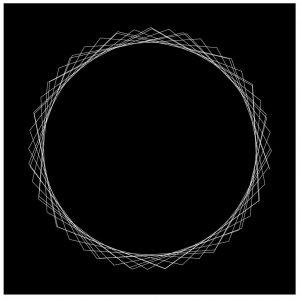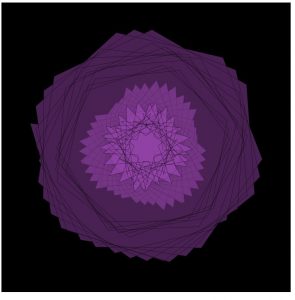function setup() {
createCanvas(400, 400);
}
function draw() {
background(0);
fill(186, 85, 211, 100);
strokeWeight(.25);
stroke('black');
drawHypocycloid();
}
function drawHypocycloid() {
var x;
var y;
var theta;
var nPoints = map(mouseY, 0, height, 50, 100);
beginShape();
for (var i = 0; i < nPoints; i++) {
push();
var a = map(mouseX, 0, width, 0, 50);
var n = map(mouseY, 0, height, 0, 200);
var d = map(mouseX, 0, width, 10, 20);
theta = i;
x = ((a / n) * (n - 1)*cos(theta)) - (d*(cos((n-1)*theta)));
y = ((a / n) * (n - 1)*sin(theta)) + (d*(sin((n-1)*theta)));
vertex(x + width/2, y + height/2);
pop();
}
endShape(CLOSE);
beginShape();
for (var i = 0; i < nPoints; i++) {
push();
var a = map(mouseX, 0, width, 100, 0);
var n = map(mouseY, 0, height, 400, 0);
var d = map(mouseX, 0, width, 10, 20);
theta = i;
x = ((a / n) * (n - 1)*cos(theta)) - (d*(cos((n-1)*theta)));
y = ((a / n) * (n - 1)*sin(theta)) + (d*(sin((n-1)*theta)));
vertex(x + width/2, y + height/2);
pop();
}
endShape(CLOSE);
beginShape();
for (var i = 0; i < nPoints; i++) {
push();
var a = map(mouseX, 0, width, 0, 100);
var n = map(mouseY, 0, height, 0, 400);
var d = map(mouseX, 0, width, 10, 20);
theta = i;
x = ((a / n) * (n - 1)*cos(theta)) - (d*(cos((n-1)*theta)));
y = ((a / n) * (n - 1)*sin(theta)) + (d*(sin((n-1)*theta)));
vertex(x + width/2, y + height/2);
pop();
}
endShape(CLOSE);
}
For this project, I focused on the hypocycloid curve. 
http://mathworld.wolfram.com/Hypocycloid.html
The hypocycloid is based on the idea of a circle, of smaller radius, rolling along the inside of a larger circle, with a point drawing it’s curve throughout the rotation. For my project I first began exploring variations based on the number of points and how adding different variables to the equation could influence it’s shape.

I then began playing around graphically, adding in 3 layers of these hypocycloid curves, and filling in the curves, to almost recreate a flower in bloom. It’s quite interesting to me how these circles are proportional to one another but act quite differently at certain points in the canvas.

I added in the d variable, which creates even more variation, based on the Astroid curve, http://mathworld.wolfram.com/Astroid.html, which is a type of hypocycloid.
![[OLD FALL 2018] 15-104 • Introduction to Computing for Creative Practice](wp-content/uploads/2020/08/stop-banner.png)